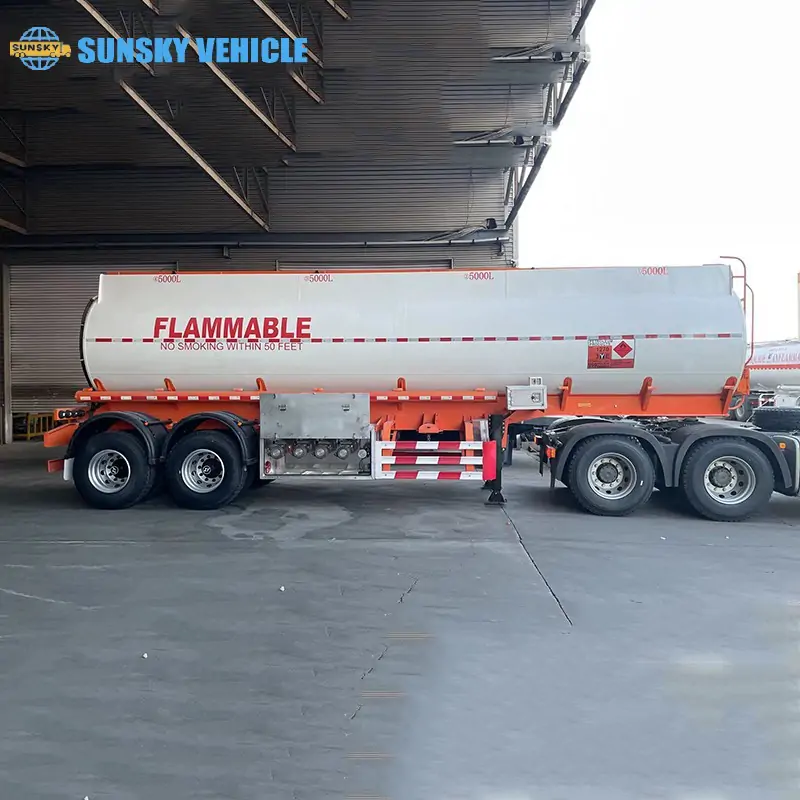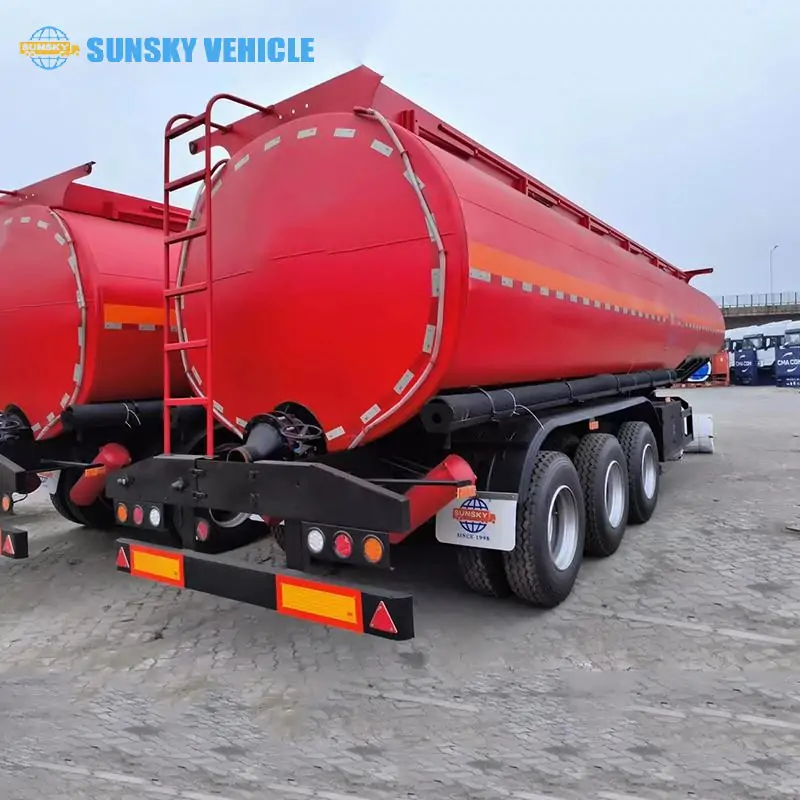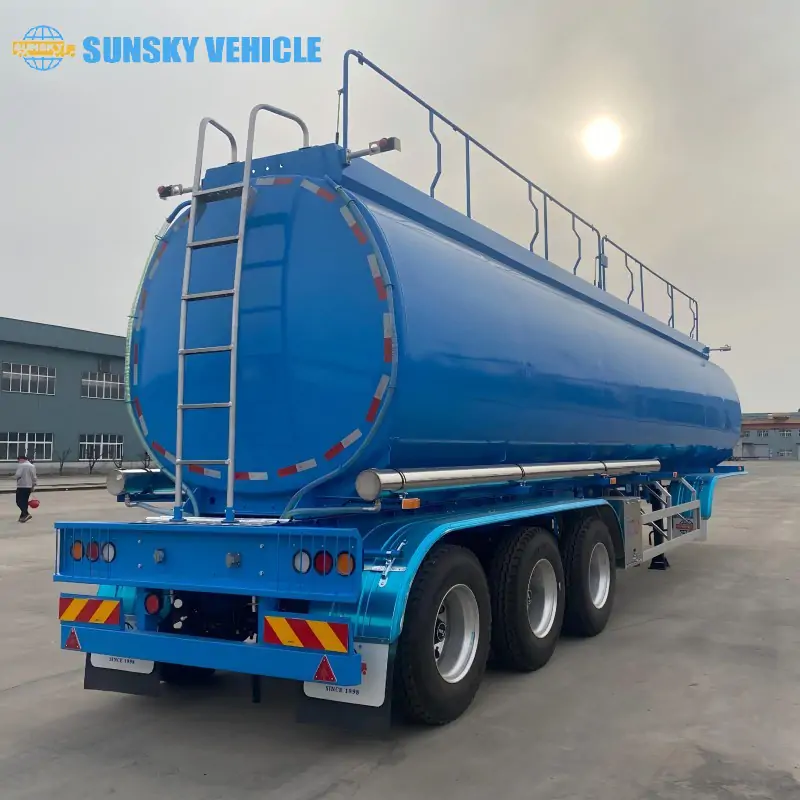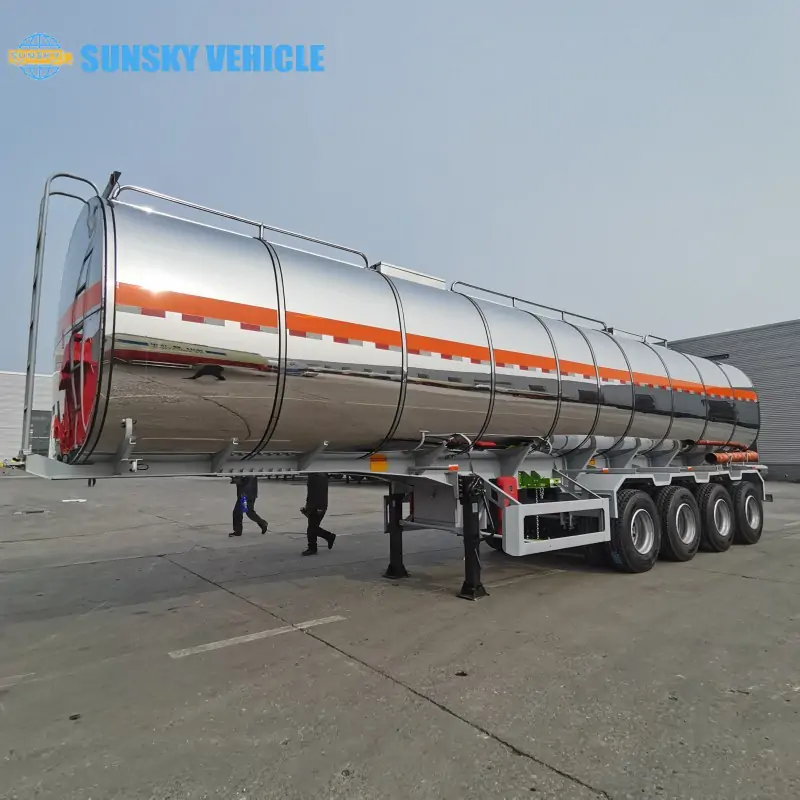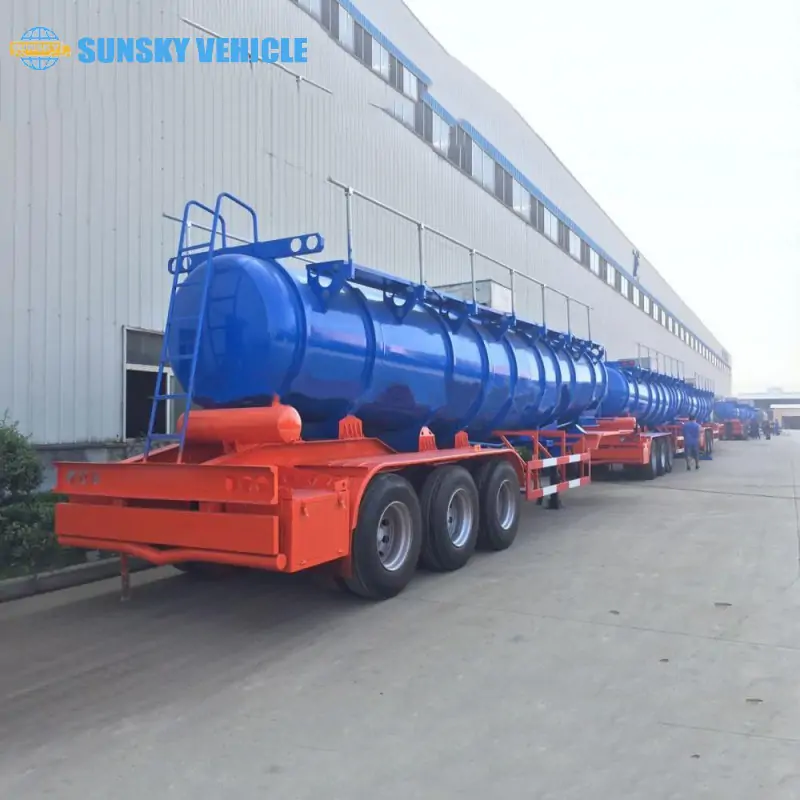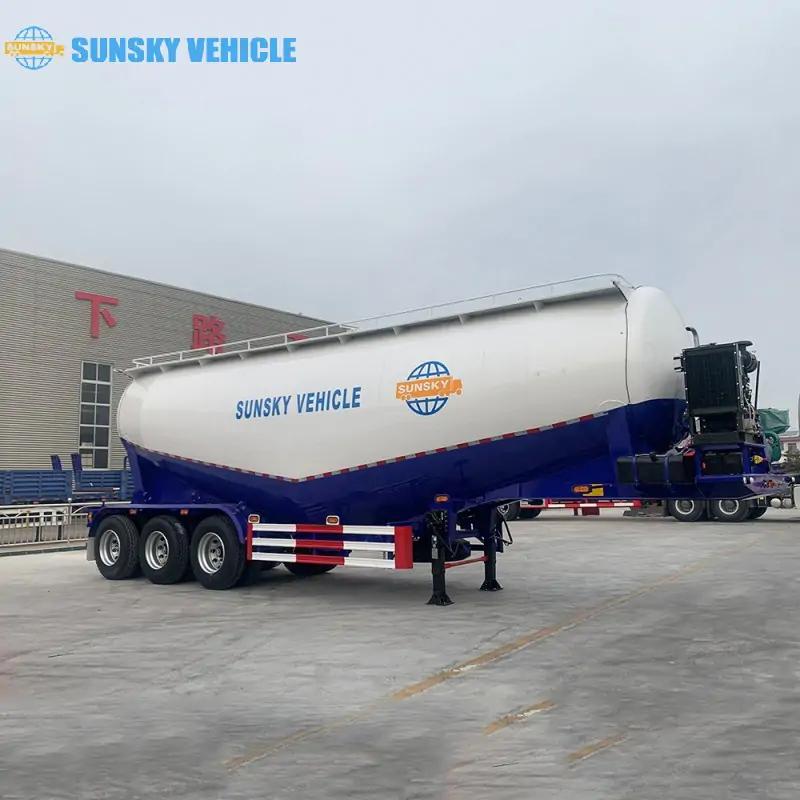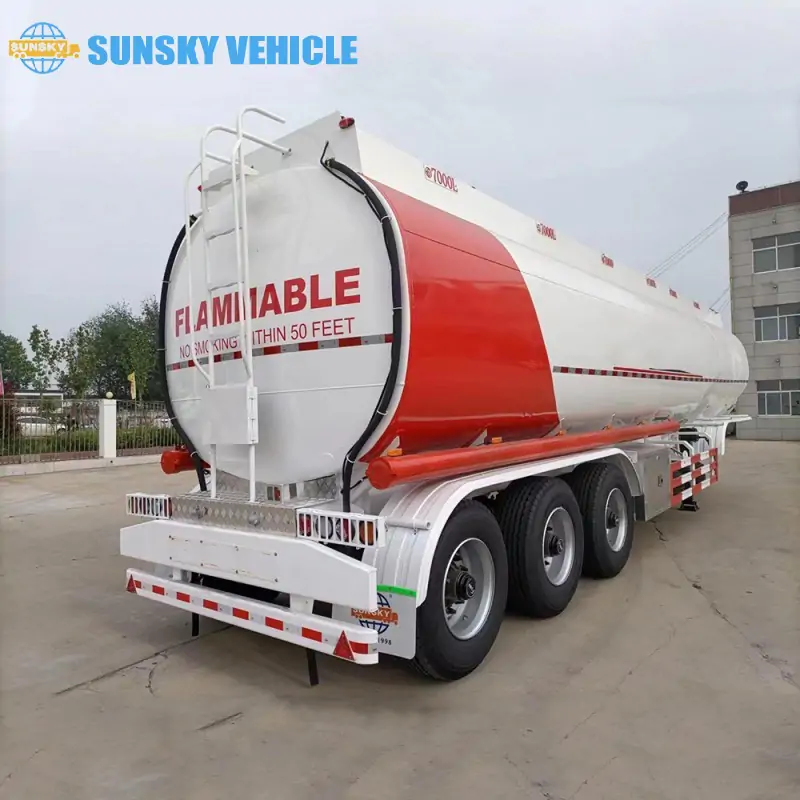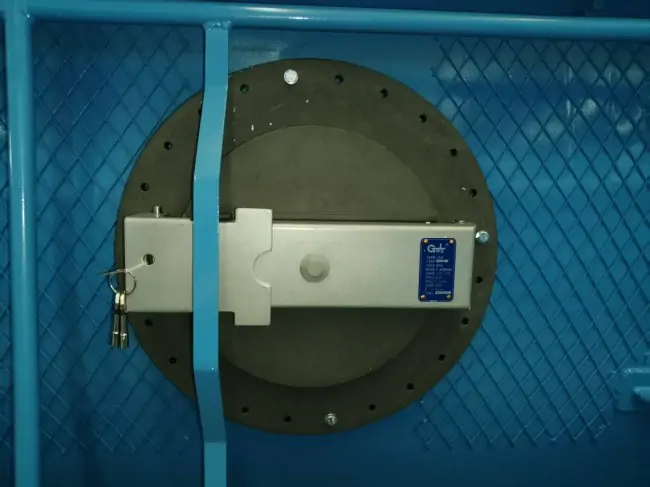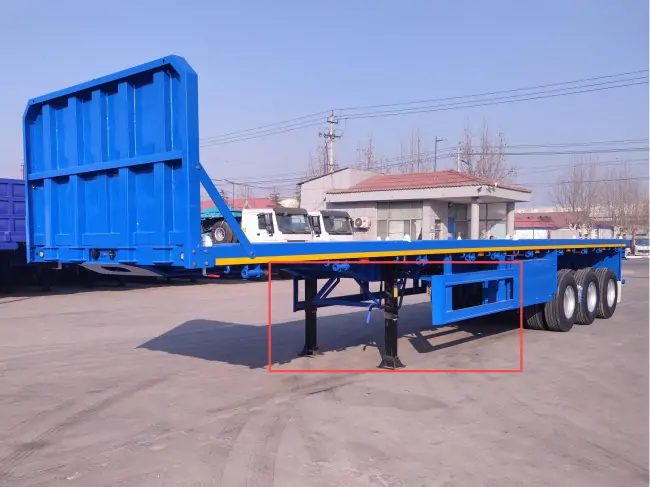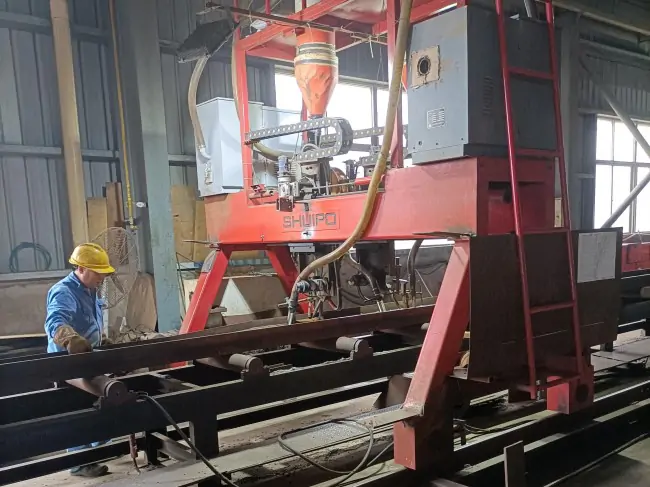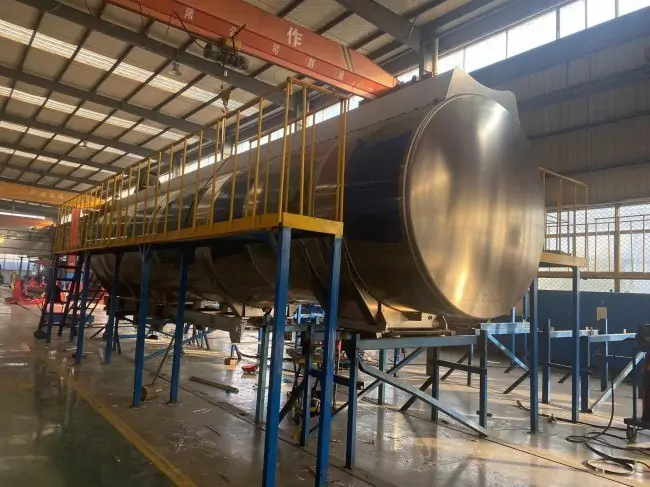Liquid & Powder Tank Trailer
Versatile solutions for transporting various liquids & powders. Durable designs, multiple capacities available. We offer expert guidance and reliable support for your bulk transport needs. Explore our range.
Click HereTypes of Tank Trailers
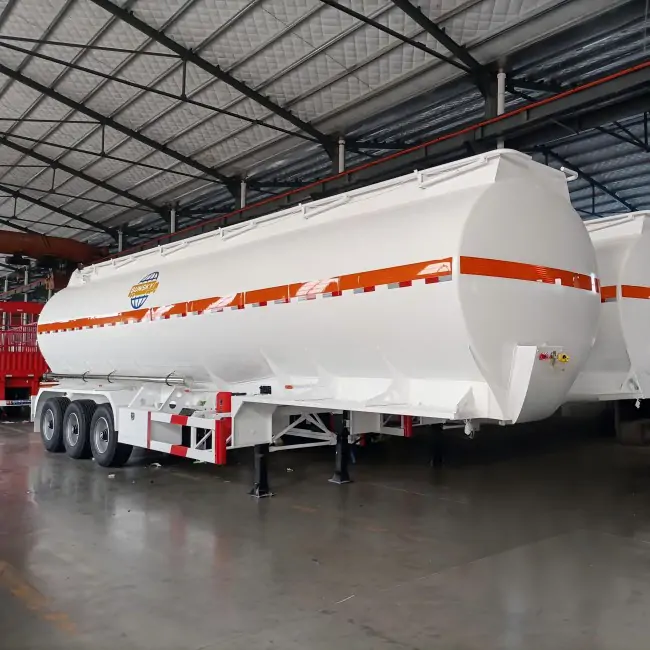
For transporting fuel, they have multiple independent tank rooms, which are convenient for packaging different oil products and ensuring the safety of liquid transportation.
| Condition | New |
|---|---|
Capacity | 45000L |
| Suspension | Spring suspension |
| Empty weight | 9000 |
Feature | Carry Fuel, Oil, Diesel etc. |
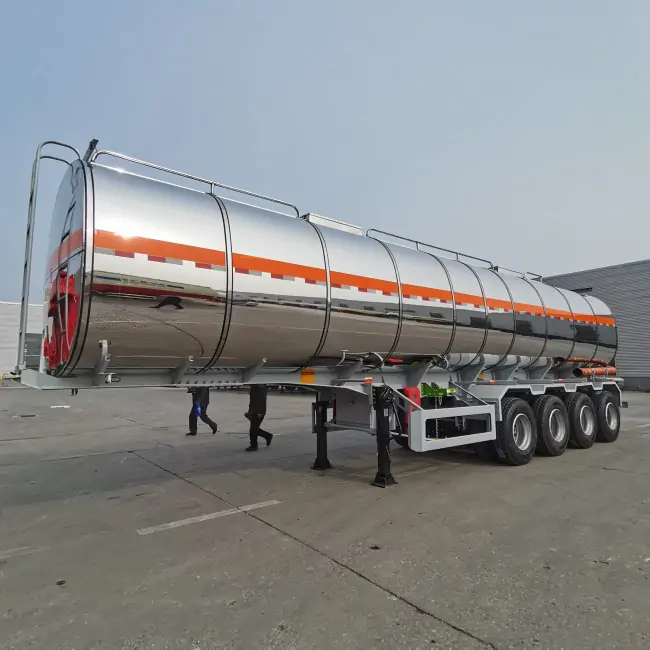
For transporting high-temperature asphalt, they are often equipped with a heating system to maintain the fluidity of the asphalt and prevent the asphalt from solidifying.
| Condition | New |
|---|---|
Capacity | 40000L |
| Suspension | Spring suspension |
| Empty weight | 9000 |
Feature | Carry asphalt,bitumen |
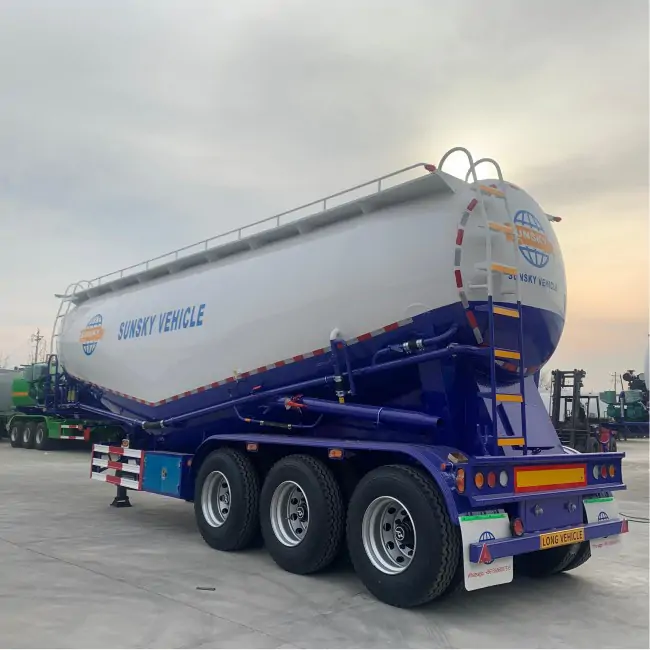
For transporting powdered cement, the tank is closed, and there are various unloading methods to prevent dust and increase efficiency.
| Condition | New |
|---|---|
Capacity | 45CBM |
| Suspension | Spring suspension |
| Empty weight | 10500kgs |
Feature | Carry bulk cement 、Ash、Powder |
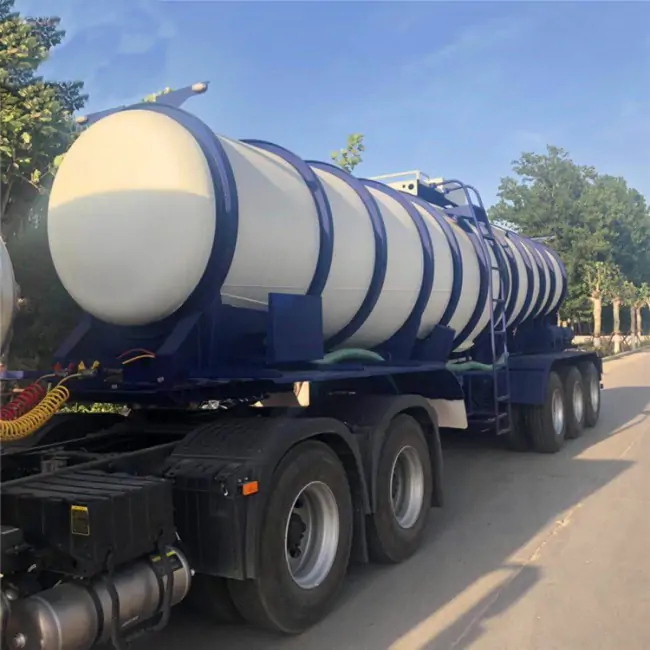
For transporting corrosive acid liquids, the tank material is special and corrosion-resistant. Strict safety protection measures are taken to ensure transportation safety.
| Condition | New |
|---|---|
Capacity | 21CBM |
| Suspension | Spring suspension |
| Empty weight | 8000kgs |
Medium | Acid/ 98% sulphuric acid |
Request your Tanker Trailer quote today
Tank Trailers Specification
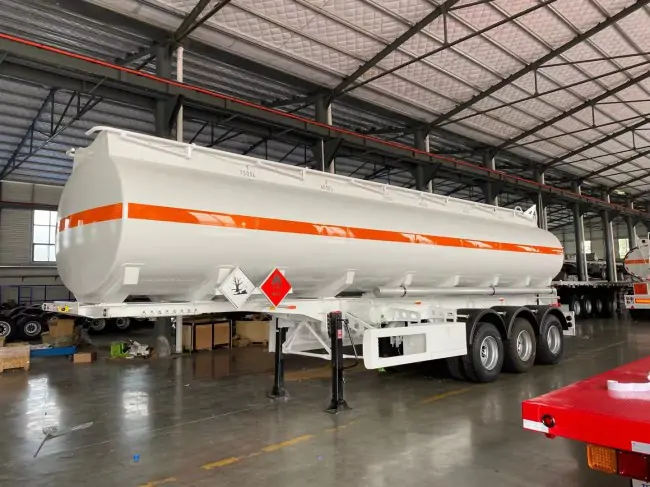
30000L fuel tank trailer
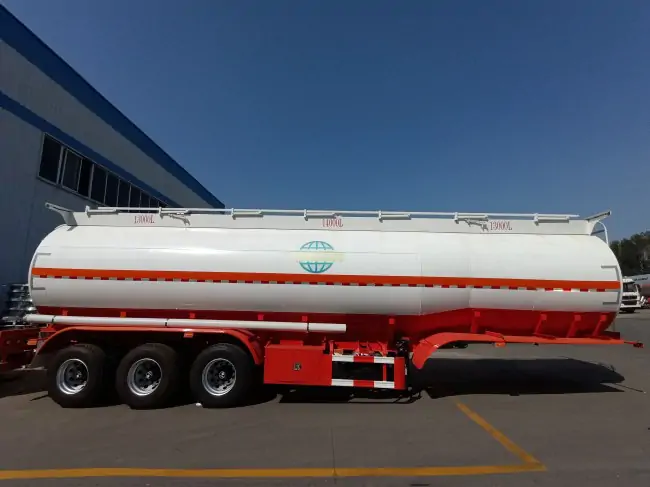
40000L fuel tank trailer
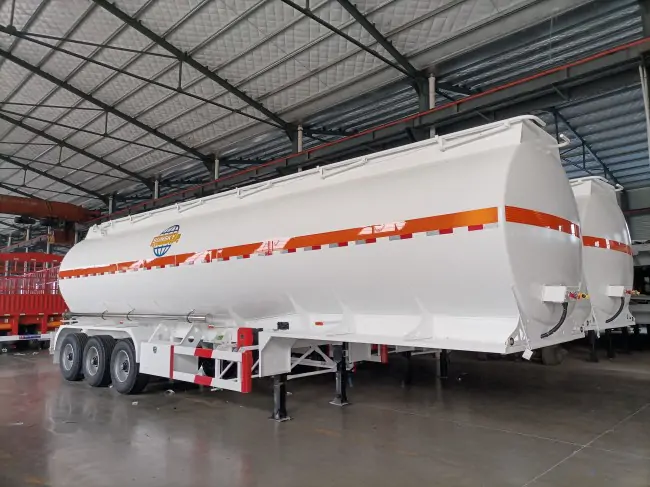
45000L fuel tank trailer
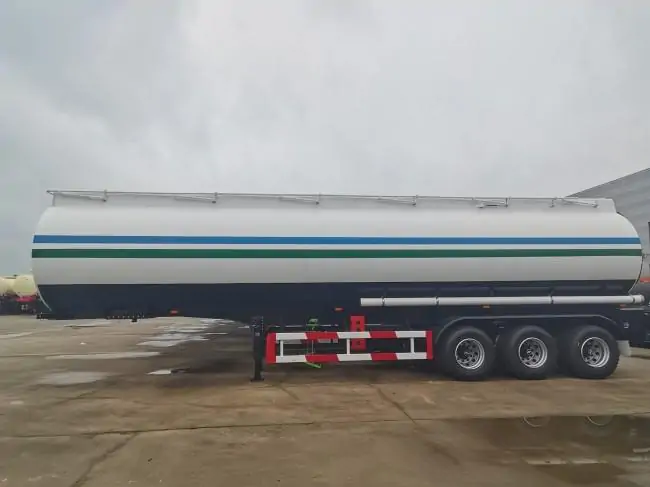
50000L fuel tank trailer
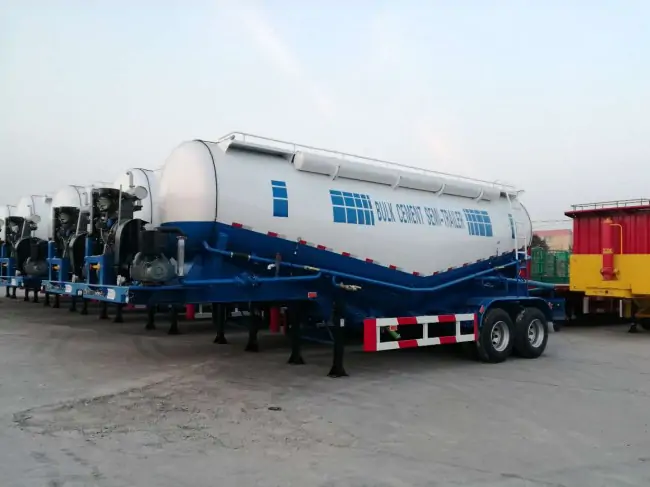
30 CBM bulk cement trailer
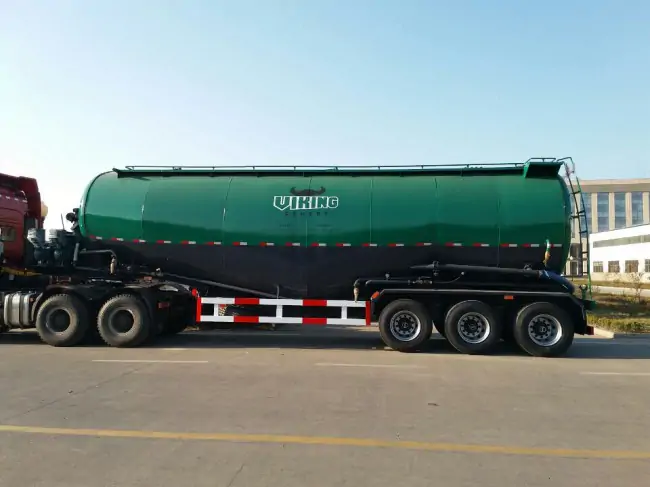
40 CBM bulk cement trailer
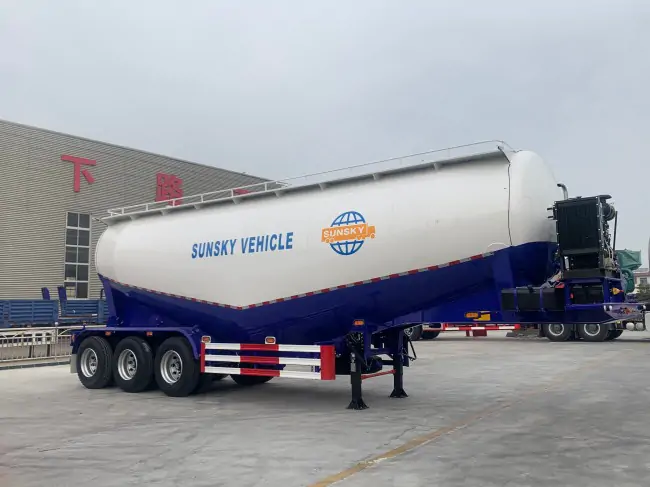
45 CBM bulk cement trailer
Sunsky Container Trailers Advantage
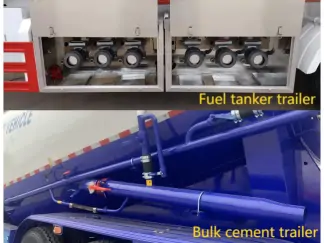
European quality unloading system, which has fast unloading speed and long service life.
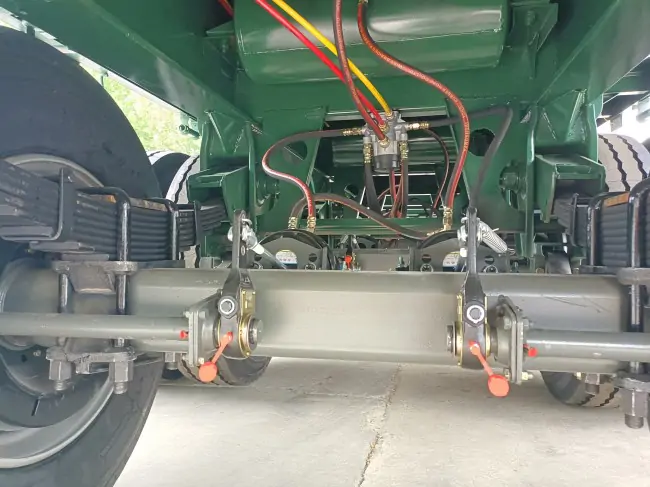
Enhanced suspension system boosts container torsion resistance, prolonging its lifespan and improving durability.
Tank Trailers
Frequently asked questions
A tanker trailer is a complex piece of equipment designed for the safe and efficient transportation of liquids, gases, or dry bulk materials. Here are its main components:
1. Tank Body:
The primary component is constructed from materials like aluminum, steel (carbon or stainless), or composites, depending on the cargo.
Can be cylindrical, elliptical, or other shapes optimized for strength and capacity.
May have multiple compartments to carry different products or for stability.
Includes manholes for access and cleaning.
2. Chassis/Frame:
Provides structural support for the tank and connects it to the tractor unit.
Typically made of high-strength steel.
Includes axles, suspension system (leaf spring, air ride, etc.), and wheels/tires.
Features landing gear (support legs) for when the trailer is detached.
3. Running Gear:
Axles: Support the weight of the trailer and cargo.
Suspension: Provides a smooth ride and protects the cargo.
Brakes: An air brake system is standard for safety.
Wheels and Tires: Chosen for load capacity and road conditions.
4. Loading and Unloading System:
Piping and Valves: A network of pipes and valves to control the flow of cargo.
Pumps: May be included for efficient loading and unloading.
Hoses and Couplings: For connecting to loading/unloading facilities.
Loading Arms/Manifolds: Entry points for loading.
Discharge Outlets: Points for unloading.
5. Safety Features:
Rollover Protection: Design elements to minimize damage in case of a rollover.
Emergency Shut-off Valves: To quickly stop the flow of cargo in an emergency.
Pressure Relief Valves: To prevent over-pressurization of the tank.
Vapor Recovery Systems: To capture and manage hazardous vapors.
Grounding/Bonding Connections: To prevent static electricity buildup.
Lighting and Reflectors: For visibility.
Anti-lock Braking System (ABS): For enhanced braking control.
6. Fittings and Accessories:
Manway Covers: Sealable access points to the tank interior.
Vents: To regulate pressure inside the tank.
Gauges: To monitor pressure and liquid levels.
Temperature Sensors: For temperature-sensitive cargo.
Walkways and Handrails: For safe access to the top of the tank.
Fenders: To protect other vehicles from spray.
The specific components and their complexity can vary depending on the type of tanker trailer (e.g., fuel, chemical, dry bulk) and the regulations governing the transportation of its specific cargo.
Tank trucks are highly versatile vehicles with a wide range of applicable scenarios and industries, primarily centered around the transportation of bulk liquids, gases, and certain dry goods. Here are some key examples:
Applicable Scenarios:
Distribution: Transporting raw materials from production sites to processing plants or finished goods to distribution centers and end-users.
Supply Chains: Ensuring a consistent supply of essential liquids and gases across various industries.
Refueling: Delivering fuel to gas stations, airports, and other facilities.
Waste Management: Transporting liquid waste for treatment or disposal.
Emergency Response: Delivering water or firefighting foam to disaster areas.
Construction: Supplying water for dust control, soil compaction, and concrete mixing, or transporting fuel and chemicals to job sites.
Agriculture: Transporting water for irrigation, liquid fertilizers, and other agricultural chemicals.
Mining: Transporting water, fuel, and various chemicals used in mining operations.
Environmental Cleanup: Recovering spilled liquids and transporting hazardous waste.
Industries Using Tank Trucks:
Petroleum and Gas: Transporting crude oil, gasoline, diesel, jet fuel, propane, butane, and other related products.
Chemical Manufacturing: Moving a wide variety of liquid chemicals, including acids, solvents, polymers, and specialized industrial chemicals.
Food and Beverage: Transporting milk, juice, edible oils, syrups, alcoholic beverages, and other liquid food-grade products, often requiring sanitary conditions.
Agriculture: Delivering water, liquid fertilizers, pesticides, and herbicides.
Waste Management: Collecting and transporting sewage, industrial wastewater, and other liquid waste.
Construction: Supplying water, fuel, and other necessary liquids to construction sites.
Water Treatment: Transporting water for drinking water supply or industrial processes.
Emergency Services: Fire departments use water tankers, and disaster relief organizations use them to deliver potable water.
Aviation: Fuel tankers are essential for refueling aircraft at airports.
Mining and Resources: Transporting water, fuel, and processing chemicals to and from mining sites.
In essence, any industry that requires the transportation of large volumes of liquids, gases, or flowable dry bulk materials relies on tank trucks for efficient and safe logistics. The specific design and features of the tank truck are tailored to the properties of the cargo being transported and the regulations governing its movement.
Tanker trailers are specialized vehicles that can efficiently transport a variety of liquids and gases over long distances. These specialized trailers are designed to transport large quantities of liquids, including gasoline, hazardous chemicals, and even drinking water and milk.
Usually we divide tank trailers into several types
Tanker trailers are generally classified into several types based on the type of cargo they are designed to transport. Here are the main classifications:
Petroleum/Fuel Tank Trailers: Designed for transporting gasoline, diesel, jet fuel, and other petroleum products. They often have multiple compartments for different grades of fuel.
Chemical Tank Trailers: Built with materials (like stainless steel or specialized alloys) and safety features to transport various liquid chemicals, which can be hazardous, corrosive, or flammable.
Dry Bulk Tank Trailers (Pneumatic Trailers): Used for transporting dry, flowable materials like cement, sand, grain, plastic pellets, and powders. They typically use air pressure to load and unload the cargo.
Food-Grade Tank Trailers: Constructed from materials like stainless steel to ensure hygiene and are used for transporting liquid food products such as milk, juice, edible oils, and syrups.
Asphalt/Bitumen Tank Trailers: Specifically designed with insulation and often heating systems to maintain the high temperature required for transporting asphalt and bitumen.
Cryogenic Tank Trailers: Engineered to transport liquefied gases at extremely low temperatures, such as liquid nitrogen, liquid oxygen, and LNG (Liquefied Natural Gas).
Water and Non-Hazardous Liquid Tank Trailers: Used for transporting water, liquid fertilizers, and other non-hazardous liquids.
These are the primary categories, and within each category, there can be further variations in design, capacity, and features depending on the specific application and regulations.
The capacity of the tank trailer used can vary significantly depending on several factors, including the specific country, regulations, road infrastructure, and the intended use of the truck.
Some standard fuel tanker trailers have capacities around 40,000 to 42,000 liters (approximately 10,500 to 11,100 US gallons).
General Range: You'll likely find tank trailer with capacities ranging from around 20,000 liters (approximately 5,300 US gallons) up to 45,000 liters (approximately 11,900 US gallons) for general fuel and liquid transport.
Smaller Trailer: Smaller tank trailer for local deliveries in more populated areas might have capacities in the 10,000 to 20,000 liter range.
Larger Trailer: For long-haul transportation on better-maintained roads, larger capacity tankers, potentially exceeding 45,000 liters, might be used where regulations allow.
Operating a fuel tank trailer is a complex and safety-critical task that requires specialized training and adherence to strict procedures. Here's a general overview of the key steps and considerations involved. This is not a substitute for professional training.
1. Pre-Trip Inspection and Preparation:
Vehicle Inspection: Thoroughly inspect the tractor unit and the trailer, including tires, brakes, lights, hoses, connections, and the tank itself for any damage or leaks.
Documentation: Ensure all necessary paperwork is in order, including the bill of lading, safety data sheets (SDS) for the fuel being transported, and permits.
Personal Protective Equipment (PPE): Wear appropriate PPE, such as gloves, safety glasses, and fire-resistant clothing.
Emergency Equipment: Verify that fire extinguishers and spill response kits are readily accessible and in good working order.
Loading Procedures (at the loading terminal):
Secure the Vehicle: Properly park and secure the tractor-trailer, often with wheel chocks.
Grounding/Bonding: Connect grounding and bonding cables between the loading rack and the trailer to prevent static electricity buildup, which can ignite flammable fuels.
Connect Loading Arm/Hose: Carefully connect the loading arm or hose to the correct fill port on the tank trailer.
Verify Product: Double-check that the correct type and grade of fuel is being loaded into the designated compartments.
Monitor Loading: Closely monitor the loading process to prevent overfilling, using gauges and automatic shut-off systems.
Close and Secure: Once loading is complete, disconnect the loading arm/hose, close all valves and fill ports securely, and disconnect grounding/bonding cables.
Inspect Seals: Verify that all seals are in place and intact.
2. Driving and Transportation:
Safe Driving Practices: Operate the vehicle defensively, maintaining safe speeds and following all traffic laws. Be aware that a loaded tanker trailer has a higher center of gravity and different handling characteristics than a dry van.
Smooth Movements: Avoid sudden acceleration, braking, and sharp turns, as these can cause the liquid cargo to shift, potentially leading to loss of control.
Anticipate Braking Distances: Loaded tankers require longer stopping distances.
Route Planning: Plan routes carefully, avoiding areas with restrictions on hazardous materials or large vehicles.
Monitoring: Regularly check gauges and mirrors to ensure the load is secure and there are no issues with the vehicle.
3. Unloading Procedures (at the delivery point):
Secure the Vehicle: Park on a level surface, engage the parking brakes, and use wheel chocks.
Warning Signs: Place warning signs or cones as required.
Grounding/Bonding: Connect grounding and bonding cables between the trailer and the receiving tank.
Connect Unloading Hose: Carefully connect the unloading hose to the correct discharge port on the tank trailer and the receiving tank.
Verify Product and Connections: Double-check that the correct fuel is being unloaded into the correct tank and that all connections are secure.
Initiate Unloading: Begin the unloading process, following the specific procedures for the trailer's unloading system (e.g., pump, gravity).
Monitor Unloading: Continuously monitor the unloading process to prevent spills or overfilling of the receiving tank.
Disconnect and Secure: Once unloading is complete, disconnect the unloading hose, close all valves and discharge ports securely, and disconnect grounding/bonding cables.
Inspect Seals (if applicable): Verify that seals are in place after unloading.
Documentation: Complete all necessary delivery paperwork.
4. Post-Trip Procedures:
Vehicle Inspection: Conduct a post-trip inspection of the trailer and tractor, noting any issues or damage.
Reporting: Report any accidents, spills, or mechanical problems immediately.
Cleaning (if required): Clean the tank interior according to regulations if a different product is to be transported next.
Parking and Securing: Park the vehicle in a designated and secure area.
You must abide by all safe driving guidelines to operate a tank truck:
Smooth driving: You have to start, slow down, and stop very smoothly because of the high center of gravity and significant liquid variations. Additionally, be fluid when changing lanes and turning.
Braking: Use steady or controlled braking if you must stop quickly to prevent an accident. Refer to Section 2.13 if you can't recall how to cease utilizing these techniques. Additionally, keep in mind that your car could roll over if you turn quickly while braking.
Curves: Reduce your speed prior to a curve and increase it a little after you pass it. For tank vehicles, the speed limit on curves could be too high.
Stopping distance: Keep in mind how far you must stop. Keep in mind that stopping distances might quadruple on slick roadways. A truck with an empty tank may take longer to stop than one with a full tank.
Avoid overbraking, oversteering, and overaccelerating during skidding. If not, your car might skid. If either the drive wheels or the trailer wheels start to skid, your car may jackknife. You need to take action to get the wheels back on track when a car starts to skid.
Loading and discharging on a tanker (such as fuel tankers, chemical tankers, or powder tankers) require careful procedures to ensure safety, efficiency, and prevent contamination or spillage. Here’s a general guide:
Loading a Tanker
Preparation & Safety Checks:
Conduct a pre-loading inspection of the tanker and equipment.
Ensure all valves, hoses, and connections are clean and in good condition.
Confirm the tanker is properly grounded to prevent static electricity buildup.
Verify the product to be loaded matches tanker specifications and capacity.
Wear appropriate personal protective equipment (PPE).
Positioning the Tanker:
Park the tanker securely and engage the parking brake.
Position the tanker near the loading station, aligning loading ports or manifolds.
Connecting Equipment:
Connect loading hose or pipeline to the tanker’s loading inlet.
Ensure all connections are tight and leak-free.
Check that the tanker’s internal valves are closed before starting.
Loading Process:
Open the loading valve slowly to start filling.
Monitor loading rate to avoid overfilling or excessive pressure.
Check gauges or level indicators to track the liquid level inside.
Use overfill protection systems if available.
Avoid air pockets by filling smoothly and steadily.
Completion & Disconnection:
Stop loading when tanker reaches designated capacity.
Close loading valves securely.
Disconnect hoses safely, avoiding spills.
Securely close all manholes and access points.
Perform a final inspection for leaks or damage.
Discharging (Unloading) a Tanker
Preparation & Safety Checks:
Confirm the receiving facility is ready and compatible.
Inspect hoses, valves, and connections for integrity.
Ensure tanker is properly grounded.
Wear PPE suitable for the product.
Positioning the Tanker:
Park the tanker at the unloading station securely.
Engage parking brake and chock wheels if necessary.
Connecting Equipment:
Connect discharge hose or pipeline to tanker outlet.
Make tight, secure connections.
Discharge Process:
Open the discharge valve slowly to start unloading.
Use pumps if necessary to assist discharge (e.g., centrifugal or diaphragm pumps).
For powder tankers, pneumatic systems or gravity unloading may be used.
Monitor flow rate and pressure.
Check receiving tanks or containers to avoid overfilling.
Completion & Disconnection:
Close discharge valves once unloading is complete.
Disconnect hoses carefully, avoiding spills or contamination.
Perform final safety inspection.
Close and secure all tanker openings.
Connect with us
Ready to partner? We’re convinced Sunsky Vehicle is your best choice! Reach out through the form or by phone.

*Our team will answer your inquiries within 24 hours.
*Your information will be kept strictly confidential.
More About tank Trailer
Contact Info
-
+86 13666007515
-
sunskyvehicle@gmail.com
-
No.99 Xiangyu Road, Xiamen Free Trade Zone,HULI DISTRICT, XIAMEN,CHINA Factory address: Liangshan district, Jining city, Shandong, China
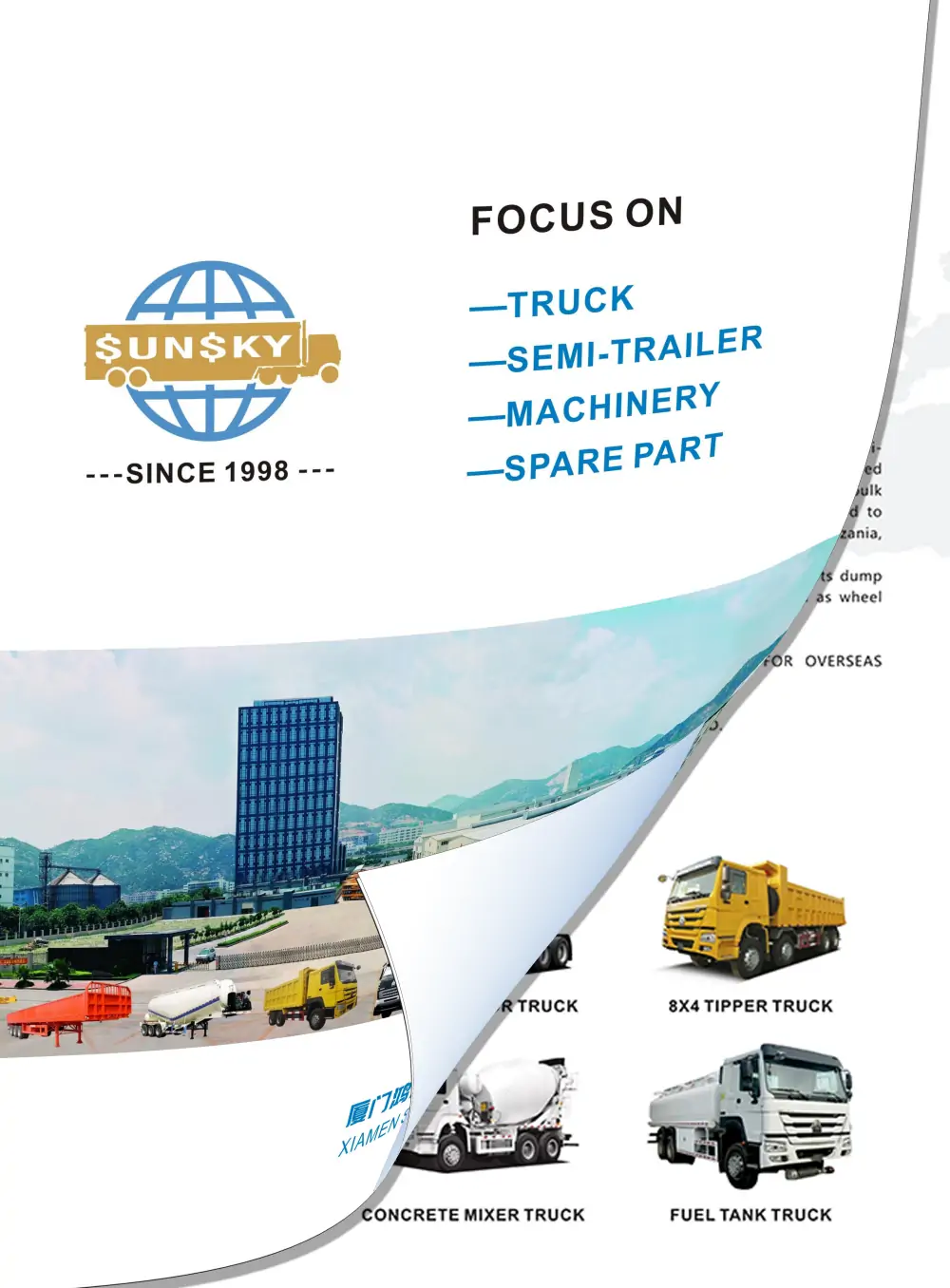
Copyright © 2020 Xiamen Sunsky Vehicle Co.,Ltd..All Rights Rese Co.,Ltd..All Rights Reserved.
Get A Quote
The more details you provide, the faster we can quote.
*Our team will answer your inquiries within 12 hours.
*Your information will be kept strictly confidential.

